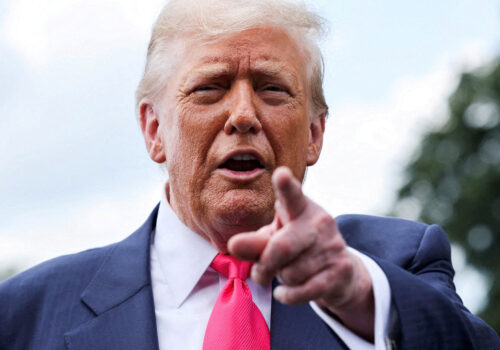The United States wants to secure its supply chains and revitalize domestic manufacturing, but when it comes to minerals, it’s still playing catch up—and not always with the right playbook. On August 1, the Trump administration launched sweeping new copper policies, including steep tariffs on semi-finished copper products and a domestic sales requirement. The announcement came just weeks after the US Department of Defense finalized a multibillion-dollar deal supporting the US-based rare earth company MP Materials—a targeted move to strengthen an important link in US mineral supply chains. Together, the two decisions reveal divergent approaches to mineral policy—but only one tackles the United States’ most acute supply chain vulnerabilities.
The United States remains heavily dependent on imports for both raw materials and the capacity to process them. Not all supply chains are equally vulnerable, however, and not all interventions are equally helpful. A policy that works for rare earths may be counterproductive when applied to copper, and vice versa.
The Trump administration’s two recent policy interventions highlight the importance of tailoring mineral policy on a case-by-case basis. The copper tariff, though less dramatic than feared, uses a mismatched tool to address a minor part of the problem by tariffing trade in finished goods while leaving core processing gaps unaddressed. By comparison, the administration’s public-private partnership with MP Materials strikes at the heart of midstream supply chain challenges for rare earths (though it also raises real concerns about creating new forms of market distortion given its overly generous price floor).
Together, they highlight a core truth in minerals policy: Success is dependent on correctly diagnosing the problem and picking the right tool for the right part of the supply chain. Getting that wrong doesn’t just waste public money and raise prices. It risks making US supply chains less resilient.
Different minerals, different markets, different challenges
Copper and rare earths policies need to navigate fundamentally different market challenges. Copper is a globally traded commodity with a competitive, liquid market and diverse suppliers. The US supply chain’s main vulnerability for copper lies in the poor economics of domestic smelting and refining, though stable trade with diverse partners helps bridge this gap. Rare earths, by contrast, are a niche market dominated by China at every stage. Due to the market’s immaturity, it is marked by high price volatility and opaque dynamics.
These differences mean copper policies need to focus on bolstering midstream economics and reinforcing stable trade partnerships. Rare earths policy, in contrast, should focus on de-risking private investment to help build a domestic supply chain from the ground up.
Copper: Right diagnosis, wrong medicine
The administration’s new copper policy is less sweeping than some analysts initially feared. The final rule imposes a 50 percent tariff on semi-finished and copper-intensive derivative products, while sparing imports of copper concentrates, cathodes, and other raw or intermediate inputs that US industry relies on. It also introduces a domestic sales requirement for all stages of the supply chain spared from tariffs and tightens export controls on high-quality copper scrap.
While this moderation is helpful and likely reflects industry feedback, the approach still misses the mark. The central constraint in the US copper supply chain isn’t semi-finished products; it’s the midstream. The United States produces almost as much copper ore as it consumes, but it lacks the capacity to process it. More than half of domestically mined copper is currently shipped abroad for smelting and refining. Once processed, generally by allies, it often returns as cathodes or wire rod for US manufacturers to fabricate into semi-finished products like pipes, tubes, and cables. The new 50 percent tariff targets these semi-finished copper products.
The 50 percent tariff, by contrast, targets semi-finished copper products such as pipes, tubes, and wires. These are already produced competitively in the United States, and the domestic industry is in relatively strong shape. Effectively, these new measures protect a segment of the copper supply chain that is already relatively healthy, while leaving the system’s weakest link—smelting and refining—largely untouched. To be fair, the tariffs will likely be effective in boosting some US manufacturers that make these products and in keeping more of the supply chain at home, but it is unlikely to spur new investment in smelting infrastructure to address the real strategic vulnerability. Worse, it may raise costs for downstream sectors, such as automotive manufacturing and construction.
The new domestic sales requirement for copper products (starting at 25 percent and rising to 40 percent by 2029) and export controls on copper scrap signal a worthy ambition to retain more copper for domestic use. But without addressing the economic barriers to expanding US smelting capacity, such as high operational costs and thin processing margins, these policies are likely an insufficient signal to incentivize more domestic smelting capacity. Without increased capacity, much of this feedstock has nowhere to go. The result could be a glut of unsellable material or rising costs for miners if export pathways shrink faster than new processing comes online.
In short, none of these measures tackle the real gap in the copper supply chain: midstream infrastructure. The United States has wisely realized that it can’t tariff its way out of its smelting deficit. However, it needs to widen its toolbox, focusing on financial incentives for domestic processing, permitting streamlining, and strategic partnerships with allies who help bridge midstream capacity gaps.
Rare earths: A more targeted approach—but just the beginning
In contrast, the Department of Defense’s multibillion-dollar partnership with MP Materials—a company that operates the only active US rare earths mine and is leading efforts to scale domestic magnet production—represents a more targeted attempt to shore up a deeply fragile supply chain. The United States is almost entirely dependent on China for rare earth separation and magnet production—two critical midstream stages that are vital for defense systems, automotive manufacturing, and advanced technologies.
To address this, the July 10 MP Materials deal ambitiously bundles a series of tools that go beyond traditional grants or procurement:
- A ten-year offtake agreement for permanent magnet purchase from MP’s announced “10x Facility,” a second manufacturing plant that will bring MP’s total permanent magnet manufacturing capacity to an estimated ten thousand metric tons in 2028
- A ten-year price floor ($110 per kilogram for neodymium-praseodymium [NdPr] oxide) to help de-risk market volatility
- A $150 million loan to expand MP’s heavy rare earth separation capabilities
- Acquisition of $400 million in preferred stock to boost rare earths separation and processing capabilities, as well as magnet production capacity
- Enough guaranteed demand to unlock $1 billion in commercial debt and a $500 million additional agreement with Apple
This is not just subsidy for subsidy’s sake; it’s a structured market-making intervention that tackles the clear chokepoints. MP Materials’ magnet facilities are expected to exceed defense demand by the end of the decade, helping to backfill commercial markets as well.
But the design isn’t without risk. First, anchoring a rare earths strategy around an intervention this large in a single company, MP Materials, could crowd out competitors and reduce the innovation pressure that comes with competition, slowing technical progress and driving inefficiencies over time. Encouragingly, recent White House meetings with a broader group of rare earths firms signal an intent to replicate key elements of the deal with a more diverse pool of domestic players. Only time will tell if the administration can foster enough competition to maximize the value of its investment, but if additional deals quickly materialize then it’s headed in the right direction.
Second, the price floor itself is strikingly high. At $110 per kilogram for NdPr oxide, it’s well above current market levels. Price supports are critical to launch a US rare earths industry (as we’ve written about here, suggesting a price floor tariff), but overgenerous price supports can create unhealthy dependencies. The United States might end up overpaying for supply or sustaining an artificial market that fails to mature.
Still, rare earths remain an exceptional case: The industry is small enough in dollar terms to justify large-scale intervention and concentrated enough that a well-structured group of domestic players can quickly shift the market. If successful, similar niche markets could benefit from a similar approach. However, scaling similar tools across more commoditized minerals would generally be prohibitively expensive and hard to justify.
Lessons for a smarter critical minerals strategy
These two cases lead to one resounding conclusion: The United States needs a mineral-by-mineral strategy that aligns policy tools with real-world constraints.
More niche materials, such as rare earths, require substantial government intervention because of acute geopolitical exposure, few global suppliers, and an extraordinarily volatile market. Smart policy here means managing demand risk, catalyzing capital, and stabilizing prices to nurture a strategic ecosystem.
For more commoditized minerals such as copper, supply chains would benefit more from regulatory reform, targeted infrastructure support, and diversified trade partnerships with allies who have more competitive smelting capacity.
As the US government continues its Section 232 investigations into tariffing other minerals, it must embrace differentiated, bold, and measured policy design. Even well-meaning interventions can misfire if they target the wrong supply chain segment. Tariffs are often a blunt instrument, and effective industrial policy requires precision.
What’s needed is a broader, more flexible playbook that can scale what works—strategic offtakes, fast tracking priority permits, supporting innovation—without locking the United States into rigid or inefficient solutions. Above all, policymakers must tailor the tool to the mineral.
Alexis Harmon is an assistant director at the Atlantic Council’s Global Energy Center.
Reed Blakemore is the director of research and programs at the Global Energy Center.
Further reading
Fri, Aug 1, 2025
How Donald Trump remade global trade
New Atlanticist By Josh Lipsky
The US president has smashed the system, but the speed and scale of the smashing owes to a system that had been growing increasingly brittle for years.
Fri, Apr 18, 2025
Tariffs can help secure US critical mineral supply chains—if they’re done right
New Atlanticist By Reed Blakemore, Alexis Harmon
US tariffs on critical minerals should be precisely targeted and coupled with robust federal support for domestic mining.
Fri, Jun 13, 2025
Mapping China’s strategy for rare earths dominance
Issue Brief By Craig Hart
China has built a commanding monopoly over rare earths.
Image: Technician inspecting manufactured bars of copper. REUTERS




